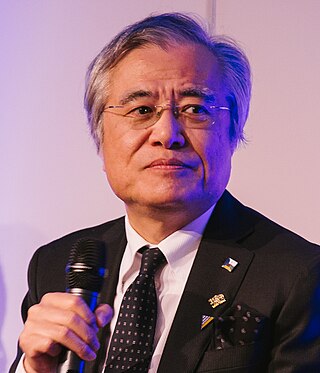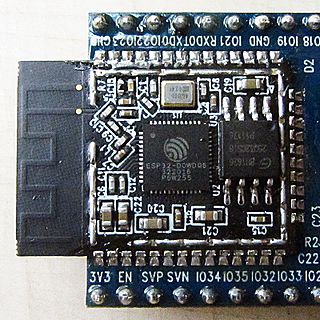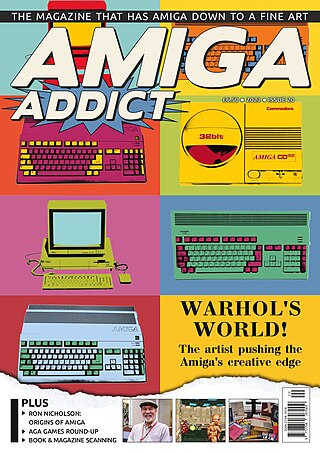Related Research Articles

The Atari 2600 is a home video game console developed and produced by Atari, Inc. Released in September 1977 as the Atari Video Computer System, it popularized microprocessor-based hardware and games stored on swappable ROM cartridges, a format first used with the Fairchild Channel F in 1976. The VCS was bundled with two joystick controllers, a conjoined pair of paddle controllers, and a game cartridge—initially Combat and later Pac-Man. Sears sold the system as the Tele-Games Video Arcade. Atari rebranded the VCS as the Atari 2600 in November 1982 alongside the release of the Atari 5200.

A personal area network (PAN) is a computer network for interconnecting electronic devices within an individual person's workspace. A PAN provides data transmission among devices such as computers, smartphones, tablets and personal digital assistants. PANs can be used for communication among the personal devices themselves, or for connecting to a higher level network and the Internet where one master device takes up the role as gateway.

Jay Glenn Miner was an American integrated circuit designer, known primarily for developing graphics and audio chips for the Atari 2600 and Atari 8-bit computers and as the "father of the Amiga".

The Atari 8-bit computers, formally launched as the Atari Home Computer System, are a series of 8-bit home computers introduced by Atari, Inc. in 1979 with the Atari 400 and Atari 800. It is the first home computer architecture with coprocessors, enabling more advanced graphics and sound than most of its contemporaries. Video games are key to its software library, and the 1980 first-person space combat simulator Star Raiders is considered the platform's killer app.
Ultra-wideband is a radio technology that can use a very low energy level for short-range, high-bandwidth communications over a large portion of the radio spectrum. UWB has traditional applications in non-cooperative radar imaging. Most recent applications target sensor data collection, precise locating, and tracking. UWB support started to appear in high-end smartphones in 2019.

Kaboom! is an action video game published in 1981 by Activision for the Atari 2600. The gameplay was based on the Atari arcade video game Avalanche (1978), with the game now involving a Mad Bomber who drops bombs instead of falling rocks. Kaboom! was programmed by Larry Kaplan with David Crane coding the graphics for the buckets and Mad Bomber. It was the last game designed by Kaplan for Activision, who left the company shortly after the release of the game. The game was later ported by Paul Wilson for the Atari 5200 system.

Wireless communication is the transfer of information (telecommunication) between two or more points without the use of an electrical conductor, optical fiber or other continuous guided medium for the transfer. The most common wireless technologies use radio waves. With radio waves, intended distances can be short, such as a few meters for Bluetooth or as far as millions of kilometers for deep-space radio communications. It encompasses various types of fixed, mobile, and portable applications, including two-way radios, cellular telephones, personal digital assistants (PDAs), and wireless networking. Other examples of applications of radio wireless technology include GPS units, garage door openers, wireless computer mouse, keyboards and headsets, headphones, radio receivers, satellite television, broadcast television and cordless telephones. Somewhat less common methods of achieving wireless communications involve other electromagnetic phenomena, such as light and magnetic or electric fields, or the use of sound.

Ken Sakamura, as of April 2017, is a Japanese professor and dean of the Faculty of Information Networking for Innovation and Design at Toyo University, Japan. He is a former professor in information science at the University of Tokyo. He is the creator of the real-time operating system (RTOS) architecture TRON.

The Television Interface Adaptor (TIA) is the custom computer chip, along with a variant of the MOS Technology 6502 constituting the heart of the 1977 Atari Video Computer System game console. The TIA generates the screen display, sound effects, and reads the controllers. At the time the Atari VCS was designed, even small amounts of RAM were expensive. The chip was designed around not having a frame buffer, instead requiring detailed programming to create even a simple display.

Amiga Corporation was a United States computer company formed in the early 1980s as Hi-Toro. It is most famous for having developed the Amiga computer, code named Lorraine.
Larry Kaplan is an American video game designer and video game programmer who, along with other ex-Atari, Inc. programmers, co-founded Activision.
Robert A. Whitehead is an American video game designer and programmer. While working for Atari, Inc. he wrote two of the nine Atari Video Computer System launch titles: Blackjack and Star Ship. After leaving Atari, he cofounded third party video game developer Activision, then Accolade. He left the video game industry in the mid-1980s.

Minimig is an open source re-implementation of an Amiga 500 using a field-programmable gate array (FPGA).

The WiMedia Alliance was a non-profit industry trade group that promoted the adoption, regulation, standardization and multi-vendor interoperability of ultra-wideband (UWB) technologies. It existed from about 2002 through 2009.
A wide variety of different wireless data technologies exist, some in direct competition with one another, others designed for specific applications. Wireless technologies can be evaluated by a variety of different metrics of which some are described in this entry.

A headset is a combination of headphone and microphone. Headsets connect over a telephone or to a computer, allowing the user to speak and listen while keeping both hands free. They are commonly used in customer service and technical support centers, where employees can converse with customers while typing information into a computer. They are also common among computer gamers and let them talk with each other and hear others while using their keyboards and mice to play the game.

The Atari joystick port is a computer port used to connect various gaming controllers to game console and home computer systems in the 1970s to the 1990s. It was originally introduced on the Atari 2600 in 1977 and then used on the Atari 400 and 800 in 1979. It went cross-platform with the VIC-20 in 1981, and was then used on many following machines from both companies, as well as a growing list of 3rd party machines like the MSX platform and various Sega consoles.

James Digby Yarlet Collier is a British physicist and engineer. He was the chief technology officer of Neul Limited. Previously, he held several technical and executive positions at Cambridge Silicon Radio (CSR), UbiNetics, Cambridge Consultants and Schlumberger

ESP32 is a series of low-cost, low-power system on a chip microcontrollers with integrated Wi-Fi and dual-mode Bluetooth. The ESP32 series employs either a Tensilica Xtensa LX6 microprocessor in both dual-core and single-core variations, Xtensa LX7 dual-core microprocessor or a single-core RISC-V microprocessor and includes built-in antenna switches, RF balun, power amplifier, low-noise receive amplifier, filters, and power-management modules. ESP32 is created and developed by Espressif Systems, a Chinese company based in Shanghai, and is manufactured by TSMC using their 40 nm process. It is a successor to the ESP8266 microcontroller.

Amiga Addict was the first Amiga magazine to be sold in newsagents in the UK and internationally since Total Amiga magazine ceased in 2007 which has resulted in praise from the wider games press for the magazine's quality and courage, partly due to the challenges the publication faces in keeping the Amiga relevant now that it is an older niche platform.
References
- 1 2 "2015 elevated fellow" (PDF). IEEE Fellows Directory.
- ↑ Stilphen, Scott. "DP Interviews ... Joe Decuir". Digit Press. Retrieved 2 August 2017.
- ↑ Kindig, Randy (May 17, 2015). "ANTIC Interview 44 - Joe Decuir, Atari 400/800 Designer". Antic. Retrieved 2 August 2017.
- ↑ In patents assigned to Commodore Amiga
- ↑ Dave Round KF7BMC Archived 2020-08-11 at the Wayback Machine Issaquah Amateur Radio Club, ...He leaves two daughters, Deborah Freng and her husband Joe Decuir, and his daughter Gail Round...
- ↑ Decuir, Joseph (2016). "Global Humanitarian Technology Conferences". IEEE Consumer Electronics Magazine. 5 (Oct 2016): 19–29, 128. doi:10.1109/MCE.2016.2590078.